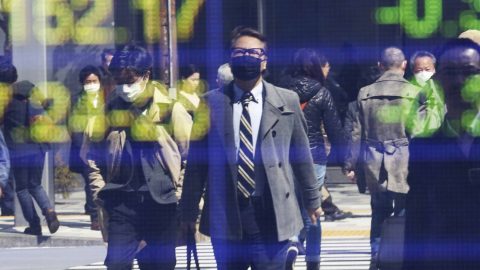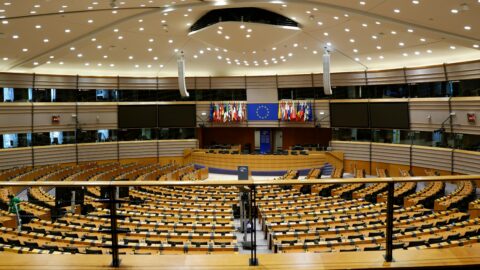The corona pandemic has thrown the world into a state of deep crisis that threatens our lives and livelihoods. The global economy is confronted by a severe recession. Both economic supply and demand have partially disintegrated due to the containment measures. Global trade has slumped, and supply chains have been disrupted. On the financial market, numerous metrics (i.e. financial conditions) have deteriorated.
The regulatory framework for new debt taken out by states has been suspended. Monetary and fiscal policies are converging. Basic freedoms such as the free movement of travellers have been curtailed. International solidarity is under scrutiny. The factors that determine the future development can only be evaluated at great uncertainty. In this article, we want to sketch out a few possible long-term consequences.
Extent of the slump
The level of uncertainty has decreased significantly in only one dimension: the economic indicators published for March and April confirm the hypothesis of a drastic slump in economic activity. In its base case scenario, the OECD expects the GDP to decline by an average of 25 percent from the moment the containment measures were launched.
Duration of the slump
Estimates of the duration of the slump are also more reliable now than they were a month ago. The rate of new infections has fallen since then. We can see the containment measures being loosened in May. In fact, some countries have already started. The take-no-prisoners approach to the containment of the reproduction rate of the virus was achieved by a far-reaching mix of broad measures: quarantine, closed shops, social distancing, stay-at-home orders, and travel bans.
The measures will have to be swapped for subtler, pointed ones in order to keep the reproduction rate at a low level (below 1): a massive expansion of the resources dedicated to tracing contacts, tests (antibodies and infection), hygiene measures, and protective masks.
Uncertainties remain
Numerous other factors remain very uncertain:
- The characteristics of the virus (e.g. mutations)
- The development of medication and vaccines (i.e. time of availability)
- The effectiveness of containment measures (further waves of infection)
Only partial recovery
The IMF predicts a contraction of global GDP of 3.0 percent in 2020, followed by growth of 5.8 percent in 2021 if the economy were to embark on a recovery in the second half of the ongoing year. However, this development would translate into a U-shaped rather than a V-shaped path of GDP.
The GDP that was simply lost in the first half of 2020 will not be recovered by the end of 2021. The cumulative global loss of goods and services not produced/provided and income not created is estimated to amount to about USD 9,000bn for 2020 and 2021. The main reason for the only partial recovery is the income lost by companies and employees, spill-over and feedback effects between sectors and countries, and uncoordinated containment measures and their loosening.
High debt
At least one sustainable effect of the pandemic is clear. The level of debt will be rising rapidly. The IMF predicts new debt taken out by states globally (i.e. budget deficits) to come to almost 10 percent of GDP this year. This will cause the global government debt ratio to jump from 83 percent to 96 percent in 2020. The government debt ratio in the developed economies is expected to rise from 105 percent to 122 percent.
Saving or investing?
To date, the various governments have been adjusting three parameters: measures concerning the virus (i.e. research), containment measures, and economic measures to mitigate against the effects of the containment measures. Another parameter – untouched so far – could determine the economic environment for the coming decade. There are two options to choose from: saving or investing. This will lay the foundation that decides whether the welfare losses (i.e. the aforementioned USD 9,000bn) will be permanent or the GDP can be kept on the growth path of recent years.
Option number 1 – saving:
if numerous economic agents (state, companies, consumers) try to reduce their debt at the same time, spending or spending growth takes a hit and as a result, economic activity is stifled. This is also the case as long as the uncertainty among consumers and companies with regard to the course of the pandemic from here on out remains elevated. The consumers’ savings ratio could increase (further), and the investment (i.e. capex) ratio of the corporate sector could fall (further).
A basic causal relationship in the economy is that of total expenditure and income being equal. This environment has got a name: secular stagnation. Sustainably low growth rates of GDP, inflation (possibly even deflation), and company earnings; interest rates at the effective lower end of the bandwidth, and elevated unemployment figures.
Option number 2 – investing:
if countries with enough leeway implement business cycle policies (i.e. higher debt), there is a chance of recovering the welfare losses and keeping the earlier level of growth. However, this is not that easy, because it would have to be a mix of supply and demand-side measures. For more details, please see below. Either way, the situation lends itself to the structural revamping of the economy under the label of “fighting climate change”.
Convergence of fiscal and monetary policy
The choice is not as obvious as it may seem at first glance. Who is supposed to pay for additional, publicly funded measures and cyclical policies? The point of origin is the ratio of interest rates to nominal economic growth. As long as the interest rates are below economic growth, the momentum of government debt is sustainable. This also applies to very high levels of debt. In some important economies (USA, Germany), this is really the case. However, if the interest rates were to rise above economic growth, the central bank could intervene and cap interest rates (“yield curve control”).
Another feature of the crisis triggered by the pandemic is the gradual convergence of monetary and fiscal policy. The Ministry of Finance steps up the budget deficit, and the central bank increases (also, government) bond purchases. Theoretically, government debt is only said to be monetised if the bond purchases are permanent. Politicians emphasise the temporary character of this step. However, in reality the government bonds will remain on the books of the central bank for a long time.
As a result, the additionally created central bank liquidity remains in circulation as well, and the key-lending rates remain low for a long time. This is true for both options (i.e. saving or investing), although option 2 retains the chance of a way out.
Inflation
Excessive demand (relative to supply)-side stimulus amid the simultaneous monetisation of government debt would (theoretically) lead inflation to rise. It is generally difficult to find the right amount of demand-side stimulus that supports the economic recovery (reflation). This is particularly true in the current situation. Too much stimulus could cause inflation, too little, deflation.
Productivity
Further permanent effects of the crisis triggered by the pandemic are the possible impairment of physical and human capital. Both would entail (even) lower productivity growth. If the phase of elevated unemployment (i.e. of the pandemic) were excessive, skills could be lost. Also, the physical capital stock could remain permanently damaged in some sectors (points of sale, tourism, transport, office buildings, factories, gastronomy, film, sports).
Pressure may mount for some products to be produced at multiple locations. The build-up of redundancies would result in lower efficiency and higher cost in favour of a higher security of supply. Here, too, supply-side fiscal policies could help. Finally, a general, partial dismantling of globalisation would cause productivity growth to decline and inflation to increase.
Conclusion
In the short run, the effects of the corona pandemic are disastrous. In the medium term, negative effects will still be noticeable, because the growth slump that we are going to experience from the first half of 2020 to the end of 2021 will probably not be recovered. In the long run, at least one effect is foreseeable: the debt ratios will increase. The question of how to deal with this phenomenon could dominate the coming decade.
Legal disclaimer
This document is an advertisement. Unless indicated otherwise, source: Erste Asset Management GmbH. The language of communication of the sales offices is German and the languages of communication of the Management Company also include English.
The prospectus for UCITS funds (including any amendments) is prepared and published in accordance with the provisions of the InvFG 2011 as amended. Information for Investors pursuant to § 21 AIFMG is prepared for the alternative investment funds (AIF) administered by Erste Asset Management GmbH pursuant to the provisions of the AIFMG in conjunction with the InvFG 2011.
The currently valid versions of the prospectus, the Information for Investors pursuant to § 21 AIFMG, and the key information document can be found on the website www.erste-am.com under “Mandatory publications” and can be obtained free of charge by interested investors at the offices of the Management Company and at the offices of the depositary bank. The exact date of the most recent publication of the prospectus, the languages in which the fund prospectus or the Information for Investors pursuant to Art 21 AIFMG and the key information document are available, and any other locations where the documents can be obtained are indicated on the website www.erste-am.com. A summary of the investor rights is available in German and English on the website www.erste-am.com/investor-rights and can also be obtained from the Management Company.
The Management Company can decide to suspend the provisions it has taken for the sale of unit certificates in other countries in accordance with the regulatory requirements.
Note: You are about to purchase a product that may be difficult to understand. We recommend that you read the indicated fund documents before making an investment decision. In addition to the locations listed above, you can obtain these documents free of charge at the offices of the referring Sparkassen bank and the offices of Erste Bank der oesterreichischen Sparkassen AG. You can also access these documents electronically at www.erste-am.com.
Our analyses and conclusions are general in nature and do not take into account the individual characteristics of our investors in terms of earnings, taxation, experience and knowledge, investment objective, financial position, capacity for loss, and risk tolerance. Past performance is not a reliable indicator of the future performance of a fund.
Please note: Investments in securities entail risks in addition to the opportunities presented here. The value of units and their earnings can rise and fall. Changes in exchange rates can also have a positive or negative effect on the value of an investment. For this reason, you may receive less than your originally invested amount when you redeem your units. Persons who are interested in purchasing units in investment funds are advised to read the current fund prospectus(es) and the Information for Investors pursuant to § 21 AIFMG, especially the risk notices they contain, before making an investment decision. If the fund currency is different than the investor’s home currency, changes in the relevant exchange rate can positively or negatively influence the value of the investment and the amount of the costs associated with the fund in the home currency.
We are not permitted to directly or indirectly offer, sell, transfer, or deliver this financial product to natural or legal persons whose place of residence or domicile is located in a country where this is legally prohibited. In this case, we may not provide any product information, either.
Please consult the corresponding information in the fund prospectus and the Information for Investors pursuant to § 21 AIFMG for restrictions on the sale of the fund to American or Russian citizens.
It is expressly noted that this communication does not provide any investment recommendations, but only expresses our current market assessment. Thus, this communication is not a substitute for investment advice.
This document does not represent a sales activity of the Management Company and therefore may not be construed as an offer for the purchase or sale of financial or investment instruments.
Erste Asset Management GmbH is affiliated with the Erste Bank and austrian Sparkassen banks.
Please also read the “Information about us and our securities services” published by your bank.



